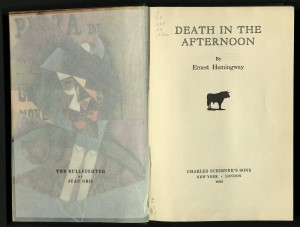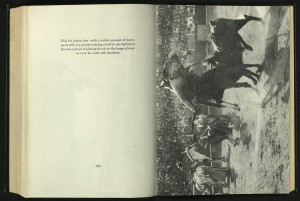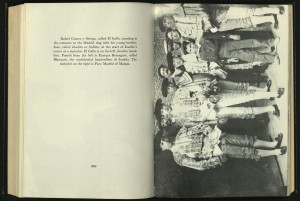Tags
bullfight, bullfighting, Charles Scribner's Sons, Death in the Afternoon, Ernest Hemingway (1899-1961), Great Depression, John Dos Passos, Juan Gris, London, Max Eastman, New York, New Yorker, photographs, Roberto Domingo, Spain, The New York Herald, The Sun Also Rises, Toros
DEATH IN THE AFTERNOON
Ernest Hemingway (1899-1961)
New York and London: Charles Scribner’s Sons, 1932
First edition, first issue
GV1107 H4 1932
Hemingway’s fascination with Spain and bullfighting, first reflected in 1926 in the novel The Sun Also Rises, was further developed in the classic Death in the Afternoon. Hemingway viewed the sport as a tragic, artistic spectacle, “…the only art in which the artist is in danger of death.” This non-fiction account of bullfighting was the object of mixed reviews at the time of publication. John Dos Passos called the book “an absolute model for how that sort of thing ought to be done,” and a review in The New York Herald said it was “full of the vigor and forthrightness of the author’s personality, his humor, his strong opinions – and language…In short,…the essence of Hemingway.” However, the New Yorker called it an act of professional suicide by a successful novelist. Max Eastman, a year later, said it was full of “sentimentalizing over a rather lamentable practice of the culture of Spain” and suggested something in the author less than manly, “a literary style of wearing false hair on the chest.” Hemingway began writing Death in late 1930. Between then and publication he spent a summer in Spain to gather photographs for the book. In all, he collected four hundred of them, although only eighty-one of them appeared in the finished product. Hemingway wrote of the bullfight, “[it] encompasses mass culture; and fine art; and its audience includes highbrow and lowbrow alike.” Published during the Great Depression, sales were hardly what they had been for his fiction. With brightly-colored frontispiece of “The Bullfigher” by cubist Juan Gris and numerous bullfighting photographs. First issue with Scribner’s “A” on copyright page and original dust jacket with full-color painting “Toros” by Roberto Domingo.





You must be logged in to post a comment.